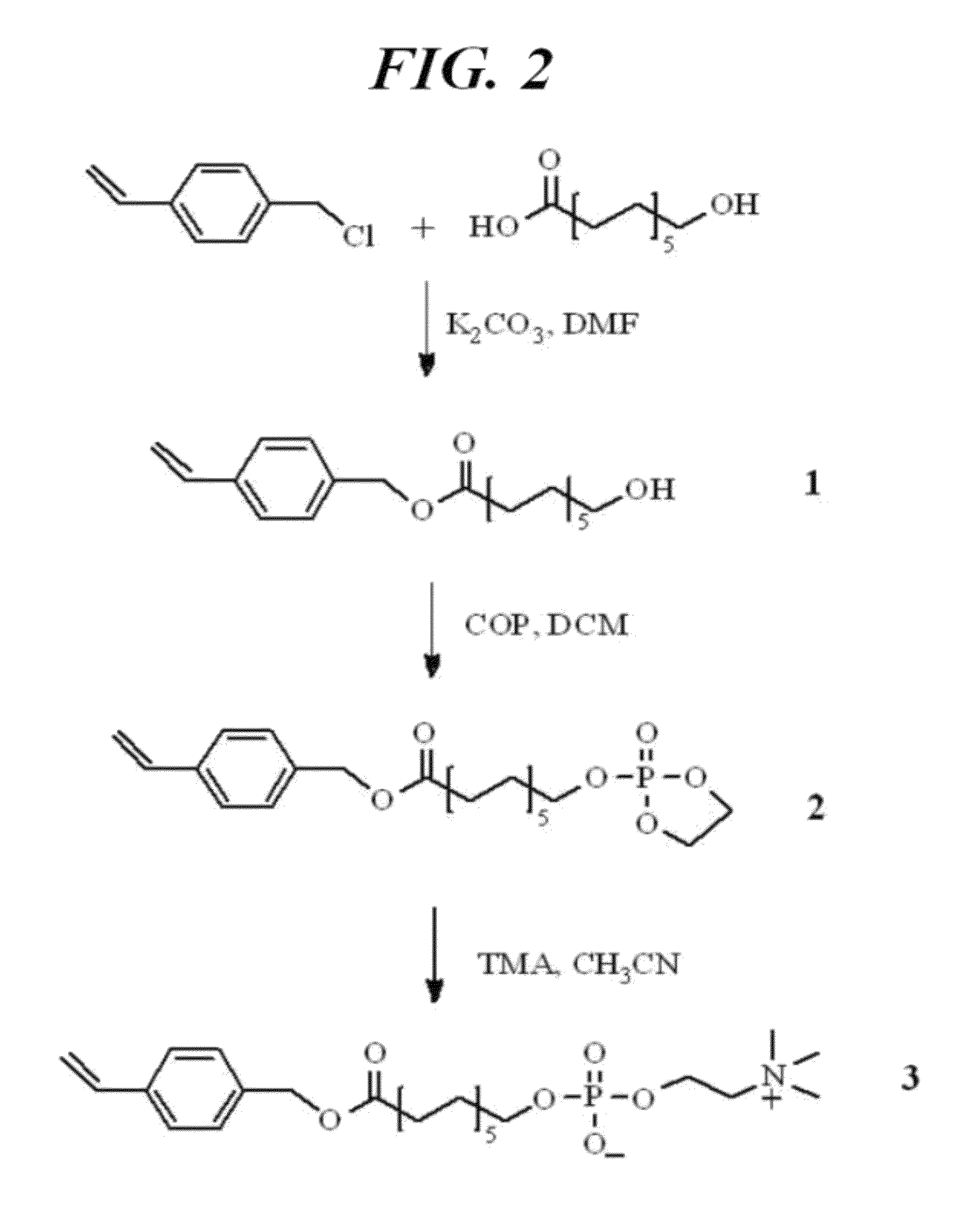Molecularly imprinted polymer for detecting the pentraxin, and method for preparing same
a technology of molecular imprinting and pentraxin, which is applied in the field of molecular imprinting structure for detection of pentraxin protein and a method for preparing same, can solve the problem of high cost of preparing an antibody, and achieve the effects of improving the detection effect, fast and effective, and high constant for binding
- Summary
- Abstract
- Description
- Claims
- Application Information
AI Technical Summary
Benefits of technology
Problems solved by technology
Method used
Image
Examples
example 1
Preparation of a Styrene-Phosphocholine Ligand
[0077]A process for preparing a styrene-phosphocholine ligand was described below with reference to FIG. 2. The products presented in FIG. 2 have been identified through NMR.
[0078]12-hydroxydecanoic acid and potassium carbonate were added into 100 ml of N,N′-dimethylformamide and stirred at a room temperature for about 10 minutes. Thereafter, 4-vinylbenzyl chloride was added thereinto and stirred while being heated at less than about 80° C. After the reaction was finished, N,N′-dimethylformamide was removed through distillation under reduced pressure. The reacting material was dissolved in dichloromethane and then washed with water. Dichloromethane layers were collected and dried with a magnesium sulfate. From the dried dichloromethane, the magnesium sulfate was removed by a depressurization filter, and dichloromethane was removed through distillation under reduced pressure. Thereafter, column chromatography purification using an eluent ...
example 2
Preparation of a Polystyrene Film, in which a Styrene-Phophocholine Ligand is Molecularly Imprinted
[0090]A method for preparing a molecularly imprinted polymer according to an illustrative embodiment is described below with reference to FIG. 5.
[0091]Total 1 ml of styrene / DVB(divinylbenzene) as a crosslink agent, and DBK(dibenzylketone) as an initiator, were added to 10 ml of a standard phosphate buffer solution (pH 7.0) with a ratio of styrene:DVB:DBK=9:1:1. Thereafter, a C-reactive protein and a styrene-phosphocholine ligand, which have been reacted together in advance, were added thereto with a molar ratio of 1:5. Since the C-reactive protein and the styrene-phosphocholine ligand were strongly bound to each other via calcium ions, they have been reacted in advance in a binding buffer solution (0.1M Tris, 5 mM CaCl2, 150 mM NaCl, and pH 8.0) thereby inducing photo-polymerization thereafter. With respect to conditions for the polymerization reaction, photo-polymerization was perform...
experimental example 1
Measurement of a Binding Force of a C-Reactive Protein to a Molecularly Imprinted Polymer
[0092]A binding force of a C-reactive protein to a molecularly imprinted polymer was analyzed by detecting a C-reactive protein through the Bradford assay method and an immunoassay method. In this case, in addition to a molecularly imprinted polymer (MIP), a molecularly non-imprinted polymer (NIP) and a polystyrene polymer (control polymer; CP) were prepared to analyze a molecularly imprinting effect. The molecularly non-imprinted polymer was prepared by using a reactive ligand without molecularly imprinting of CRP. The polystyrene polymer was prepared without using a reactive ligand and CRP.
[0093](1) Bradford Assay Method
[0094]5 μg of a CRP was added to the prepared molecularly imprinted polymer and reacted at 0° C. for 30 minutes. In order to remove a non-specifically bound protein, the reacting material was washed three times with PBS or repeatedly washed three times with a TBST buffer soluti...
PUM
| Property | Measurement | Unit |
|---|---|---|
| height | aaaaa | aaaaa |
| diameter | aaaaa | aaaaa |
| time | aaaaa | aaaaa |
Abstract
Description
Claims
Application Information
 Login to View More
Login to View More - R&D
- Intellectual Property
- Life Sciences
- Materials
- Tech Scout
- Unparalleled Data Quality
- Higher Quality Content
- 60% Fewer Hallucinations
Browse by: Latest US Patents, China's latest patents, Technical Efficacy Thesaurus, Application Domain, Technology Topic, Popular Technical Reports.
© 2025 PatSnap. All rights reserved.Legal|Privacy policy|Modern Slavery Act Transparency Statement|Sitemap|About US| Contact US: help@patsnap.com



